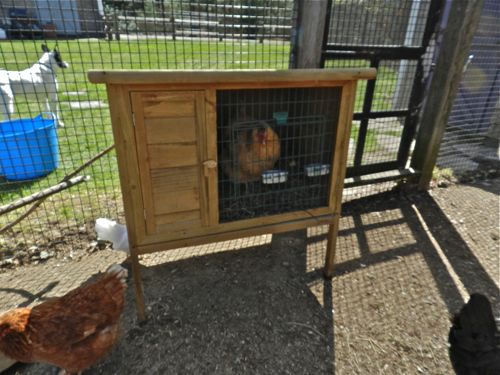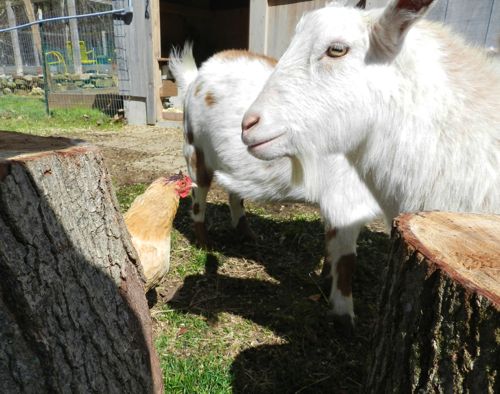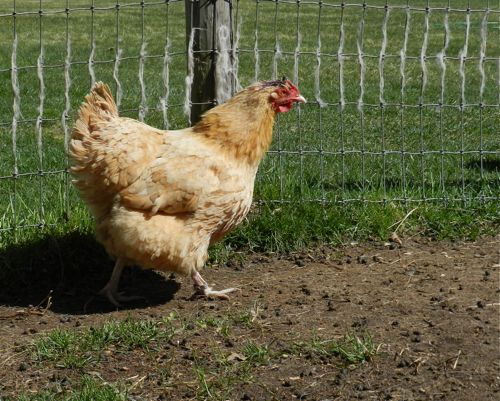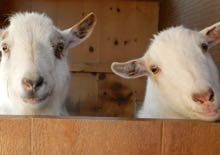Last week one of the hens tried to kill Buffy. Or, it could have been a couple of hens. I don’t know the culprit(s). All I know is that I found Buffy in a nesting box, and there was blood splattered everywhere. Half of her comb was gone. Day in and day out this has been a stable, peaceful flock. The only obvious sign of a pecking order is that the hens with the most status get the best food first. Once in awhile I’ll see a short chase of four steps, and a peck that misses.The nine hens in the Little Barn range from old to elderly. It’s not worth their energy to strut their stuff. So, that blood, worthy of a television crime show scene, was a surprise. I removed Buffy from the group. All went back as it was, with the hens doddering about and napping in the sun. There were no other attacks, so this wasn’t a case of an usurper trying to assert herself at the top of the compost heap. What happened was specific to Buffy. Something must have triggered the violence.
Buffy has lived a long life and has survived several health issues. She’s a quiet hen that minds her own business. Sometimes aggression is triggered when a hen becomes sick and weak, but Buffy doesn’t seem any slower than normal. Her manure output is the same. She’s eating and drinking fine. However, two weeks ago I noticed that part of her comb was discolored. It looked darker and shriveled. A healthy comb has a lot of blood flowing through it. I thought that perhaps Buffy was having circulation issues. I didn’t think that it was a big deal. But in fact, combs are very big deals to hens – combs are the key visual trait to how they identify each other. To us humans, a thousand brown hens in a commercial flock, all of the same breed, look the same. But to the hens, each one of them is an individual – and they know each other by their heads. Each hen has a unique comb which the other hens recognize. Change the comb and it’s like a new chicken has been inserted into the group.
Despite Buffy’s unique golden plumage, and despite the fact that she has lived with some of these hens for six years, with her comb dark and shrunken, she wasn’t recognized and was attacked as an interloper.
I put Buffy into a spare rabbit hutch, and placed the house inside of the chicken run. Buffy has food, water, shelter and a safe place to heal. The other hens get to know the “new” hen through the hutch’s wire front.
Every day I give Buffy some time in the goats’ pen, where she can scratch, dust bathe and eat grass.
Buffy spends much of her time looking at the other hens through the fence. I’ve never know a chicken to hold a grudge. The other hens aren’t puffing up their chests and challenging her through the fence. Buffy isn’t looking scared. Hopefully, when her comb is healed, I’ll be able to put Buffy back in with the flock.
Buffy is taking it all in stride.




Poor Buffy. I do hope she can be reunited with her old friends. Give her a hug (and maybe a small treat) from a reader, would you please?
Oh dear, the hierarchy of the flock is so complex isn’t it? Much more going on than we see at first glance. I remember being horrified at what happened to Ruby when she became poorly with peritonitis – our new cockerel literally cut her down to size and pecked off her comb! She spent her last weeks isolated from the flock, with visits from her best friend Phoebe.
I hope the new Buffy manages to get a place back in your flock.
Celia
x
That is so interesting about their comb identification. I also have a rabbit hutch, two story, and it’s so handy when I have to isolate a hen from the others. It stands in the center of my coop and allows the isolated hen to still feel part of the flock. And I have a second, smaller coop with an enclosed run that allows the isolated hen some outside/dirt scratching time inside the larger chicken yard. I have a couple who are on the bottom of the pecking order. They suffer being pecked to move away from the food, but fortunately there’s been no blood drawn.
When I combined two flocks I added an extra feeder and waterer. That small management step made a huge difference in bullying. Perhaps that would help in your situation, too.
Very interesting. I never knew about the comb, I hope she heals. Thanks for all the tips on your blog, they make keeping chickens easier for first timers like me!
Best wishes to my girl, Buffy. I hope she can be returned, peacefully, to the rest of the gang. I love that she gets to hang out with the goats. Such a cute picture.
So glad to hear Buffy is alright for the time being. Do the goats enjoy her company?
Buffy looks perky in that last photo. I’m really glad to see her recovery is going so well. The rabbit hutch is a great idea, as is her time in the goat yard (complete with goatie fur on the fence). You’re so smart!
Question though: Where does she sleep at night? In the hutch?
Note to self: When planning the home for my future girls, make sure there’s a space for separating a sick or bullied bird. Very important.
She stays in the hutch. It has a cozy enclosed nesting area. BTW, the hutch was a gift from a friend who no longer has a bunny. I am lucky to have such a nice one!
Poor Buffy. :( I am glad she is okay. I am doing the same with a little bantam hen that I have aquired. I keep her in a smaller pen with the other big chickens, where she is protected, and then let her out for a little while everyday when I can watch, but still she is attacked. I felt so bad for her yesterday evening when she went into the hen house with the other chicks and very bravely hopped up with them to roost and then the usual attack happened! UGH! She wants so badly to hang with the big girls, but I am not sure it will happen. It has been less than a week now, so maybe time will tell. Do you know if bantams ever get accepted by a group of regular sized hens?
Betsy is my only bantam. It helps to have outside roosts and places where only the little one can hide in. Your bantam should learn to quickly scoot out of the way of the others. You might give her a high roost that the other can’t get to. But, I think all should settle out and she’ll be fine.
I need to get outside alternative housing just in case I have such an issue. I have a big portable dog kennel that I used last summer to isolate my chicken with the fly strike but I had to keep her inside the house with air conditioning for comfort while she healed. I had the opposite problem when I introduced her back to her pals; she attacked them! I had to gradually let her out with her pals until she calmed down. She’s a heavy bird but while she recuperated she lost weight and was more fit to chase the others! Now she’s gained her weight back and isn’t so speedy.
It does help to have it on hand BEFORE you need it! That’s funny about her speeding up when thinner.
Wow! I did not know that about hens. When I read the post from last week, I wondered what triggered the attack. I mean, they’ve been living together for several years, so why now the aggression? Now I know why. I hope you will be able to reintroduce her to her old gal pals with no new incident occurring. For now, it’s good for her that you’ve moved her. Her head still looks like it’s sore but she is on the mend. Hens are more complex that we sometimes realize.
Dear sweet Buffy please mend soon. From all the girls at Dog Trot Farm.
Thanks, so much, Terry, for your positive words. We have given her a higher roost. When she is out with the big girls, she is constantly making sure she is out of their way, so maybe she is learning. She is not a fighter, though. Maybe she needs to show the big girls a thing or two! ;)
By the way, Terry, our higher roosts for the bantam are also outside. Would she do okay outside in the winter? We live in Atlanta, so it is not cold, much, but we do get some cold days.
Poor Buffy, I do hope everything goes okay. And that the hens will accept the “new” hen soon. Well with Betsy being so small I doubt she was able to do much and the Polish are so silly they probably don’t even realize her comb has changed or that she is moved away. It’s just one less feathery thing they don’t run into too.
The thing is as the older hens age and die off and you down to just one or two. Though they are silly they might, and it’s a big might with Ken’s story of his polish living so long to eight or nine years. What will you do if the Polish end up being the last two ? Will you divide up a few of the younger gems among them ?
I’m fortunate to have two coops and pens. As chickens age and the situation changes, I’m able to move things around and mix the flocks to that all is peaceful. I have a long-term plan, but it’s sure to change due to what the animals need!
Poor little girl!
I hope that I’ll never have to go through this with my hens, but at least I’m forewarned, so will recognize it if it does occur.
Thanks for the education!
PS I was looking at disapproving rabbits’s website tonight and I found two somethings I think is really neat. The first is a Rabbit Play group where owners will bring in their rabbits to socalize with each other. Their are several rules which are listed in the link, but it seems in the video that the rabbits who follow the rules really seem to like the socializing. So many butts to sniff and so little time to dominate !!! And while Candi at her age could care less about other rabbits and has her own flock of hens to interact with. Maybe some of your readers who have young rabbits might enjoy a program like this. I know your dogs Lily and Scooter enjoy their own little play dates with your friend’s dogs.
Here is the link
http://www.disapprovingrabbits.com/2012/04/one-minute-of-hoppy-hour.html
and the second is about Dougal and how his owner has started in a rabbit agility class. I was wondering if in your training of animals if you have ever done anything like that Terry with any of your rabbits.
http://www.disapprovingrabbits.com/2012/03/dougal_19.html
The sort of training I do is applicable to all animals, rabbits included. There’s a book about how to train your bunny. http://store.clickertraining.com/gestclwiyora1.html
Poor Buffy. Thank you for taking such good care of her.
I see I’m not the only one with hen aggression issues. Last week, I checked on my girls to find that they had pecked a huge hole in Henrietta’s neck and picked most of the feather off her head. The poor dear would have been dead had I not rescued her. I’m not sure what caused it, but they have lived happily together for a year (ever since they were chicks).
Right now, she is in the “infirmary” in the basement in an old dog pen for our black lab. I have GOT to get her reintegrated though, so love your idea of using the rabbit hutch IN the chicken run. I’ll have to try that. Thanks for the post!
I’ve gone the route of the crate in the basement, too. A big hassle, smelly, the hen doesn’t like it, and it’s hard to reintegrate them. Sometimes you have to do it, but now that I have an outside hutch, it’s so much better for everyone!
Terry I bet Buffy would integrate well with the goats if you provided a roost in the goats stall. That is if the goats don’t mind hen poo in their sleeping quarters.
Buffy would be quite happy to live with the goats, but the boys could become deathly ill if they eat chicken food, so I’ll Buffy won’t be bunking with them.
Goodness, Hope the girl gets better. It’s strange how hens can isolate one out of the bunch. I only have four hens but we have one that has become sorta the outcast. She seemed to be hen pecked a little at first so we put extra attention to see she was getting to eat and such; but they still shun her. We had chickens when I was a kid(alot of them) it’s appt to happpen but it’s still hard watching one get singled out. Good luck..I’m sure a solution will come along.
Didn’t know about the comb ID thing — very helpful. And good idea about the rabbit hutch for Safe House. I’ve used the cat carrier, but as you said, the hens don’t like it and it’s really too small. A good reminder about daily observation of the flock and observing small changes. I continue to learn new things from you Terry — thanks for sharing chickenalia with us.
I am visualizing hard on a rabbit hutch, or better yet, a second coop and run. Chicken goddess, send me a bit of extra cash, please!
Terry, I’m so glad you posted this. I took your class last summer & I’m a first time hen keeper and our chickens have lived peacefully together for 8 months until this past week. One of our chickens is being pecked by the others. I’ve separated her in a make shift coop in the garage. I’ve purchased the Blue-Kote that you mentioned you used on Buffy. Now I just have to wait to reintroduce her to the flock. I’m considering isolating the more aggressive birds while I reintroduce her to the others.
Hi Katy! Sometimes removing the aggressor for two days changes the dynamics and when you put her back she doesn’t regain her status. If you can, put the injured hen in a place where the flock can still see her. That make integrating her back with the flock easier. Good-luck!
Thanks for the suggestion!